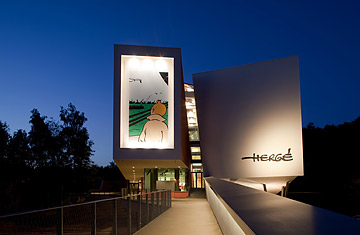
Entrance to the new Hergé Museum in Louvain-la-Neuve, Belgium.
It's an old parlor game: can you name 10 famous Belgians? Belgium may be a tiny nation, and often the butt of its neighbors' jokes, but it can claim two 20th century artistic giants who would make it onto that list: Hergé — or at least his globetrotting comic-strip character Tintin — and René Magritte, the subversive surrealist painter. Both created iconic images that are recognizable the world over. And since June 2, both of them, finally, have museums of their own in their native country, dedicated to their respective contributions to the evolution of 20th century art. The museums trace the bold innovations and ideas that show up in the artists' work while also revealing the contrasting outlooks the two men held in their parallel lives.
Situated in Louvain-La-Neuve, a new town some 20 miles (32 km) southeast of Brussels, the Hergé Museum is a stunning piece of architecture. Designed by Pritzker Prize winner Christian de Portzamparc, its sleek concrete, steel and glass form makes it look like a stranded ocean liner, an image that deliberately echoes Tintin's many maritime exploits. Built at a cost of $20 million, and financed by Hergé's second wife Fanny, the museum reflects Hergé's huge corpus of work, much of which has, until now, been languishing largely unseen in studios and bank vaults. The displays focus not only on Tintin, but also the many other comic-strip characters Hergé created, and the myriad influences on his work. (See pictures of Belgium.)
Hergé's real name was Georges Remi; his pseudonym comes from the French pronunciation of his inverted initials, R.G. He was just 21 when he created Tintin, who made his debut in January 1929 in the children's newspaper Le Petit Vingtième. The comic strip was an instant success. Readers lapped up the stories of Tintin's adventures, which Hergé filled with quick wit and rich personalities (enthusiasts say he should be recognized as a literary great). They were illustrated in a style that Hergé perfected called ligne Claire, or clear line: simple lines of almost uniform thickness, with no shading. His technique, which created an uncluttered image with robust, universal elements, influenced cartoonists that followed, such as Asterix creators Goscinny and Uderzo, and the Smurfs' Peyo. And while Tintin never made it big in America, Pop Art stars Andy Warhol and Roy Lichtenstein recognized Hergé as an inspiration for the Pop Art movement. The museum has three portraits of Hergé painted by Warhol, who once said that the Belgian artist "influenced my work as much as Disney," and Lichtenstein designed the cover for Frederic Tuten's 1996 novel Tintin in the New World. (Read: "Tintin Travels to Tinseltown.")
The Tintin comic strip ran for over half a century, but Hergé maintained that his boy wonder was always just shy of his 18th birthday. Ostensibly a reporter — although he is seen filing a story in only one frame in the entire 24-book oeuvre — Tintin took on various roles as detective, Boy Scout and secret agent. As time went by, he accumulated friends: along with his astute and faithful dog, Snowy, his retinue included cantankerous sailor Captain Haddock; eccentric egghead Professor Calculus; and the doltish, bowler-hatted, doppelgänger detectives, Thomson and Thompson. And his adventures took on more elaborate themes, from drug-smuggling to Cold War spying and even space travel; Tintin reached the moon 15 years before Neil Armstrong. Since Hergé first drew his quiffed hero, about 230 million Tintin comic books have sold around the world, translated into more than 80 languages. And now Hollywood has got its hands on him, with Steven Spielberg producing a Tintin movie trilogy in 3D. (See a TIME video about 3D.)
Hergé rarely traveled to the far-flung places he described so vividly in stories such as Tintin in Tibet and Tintin in the Congo. But he researched fastidiously, and the museum displays some of the 30,000 cuttings from magazines and newspapers that he hoarded over the years. In one of the eight themed galleries, original artwork sits alongside photos of speeding cars, royal palaces and African witch doctors, which Hergé used for reference and inspiration. "He had a forensic dedication to accuracy," says Nick Rodwell, head of Moulinsart, the organization that runs Hergé's estate. "It gave his stories that extra authenticity, making them realistic as well as visually elegant."
